NEPAL
Sink or Swim
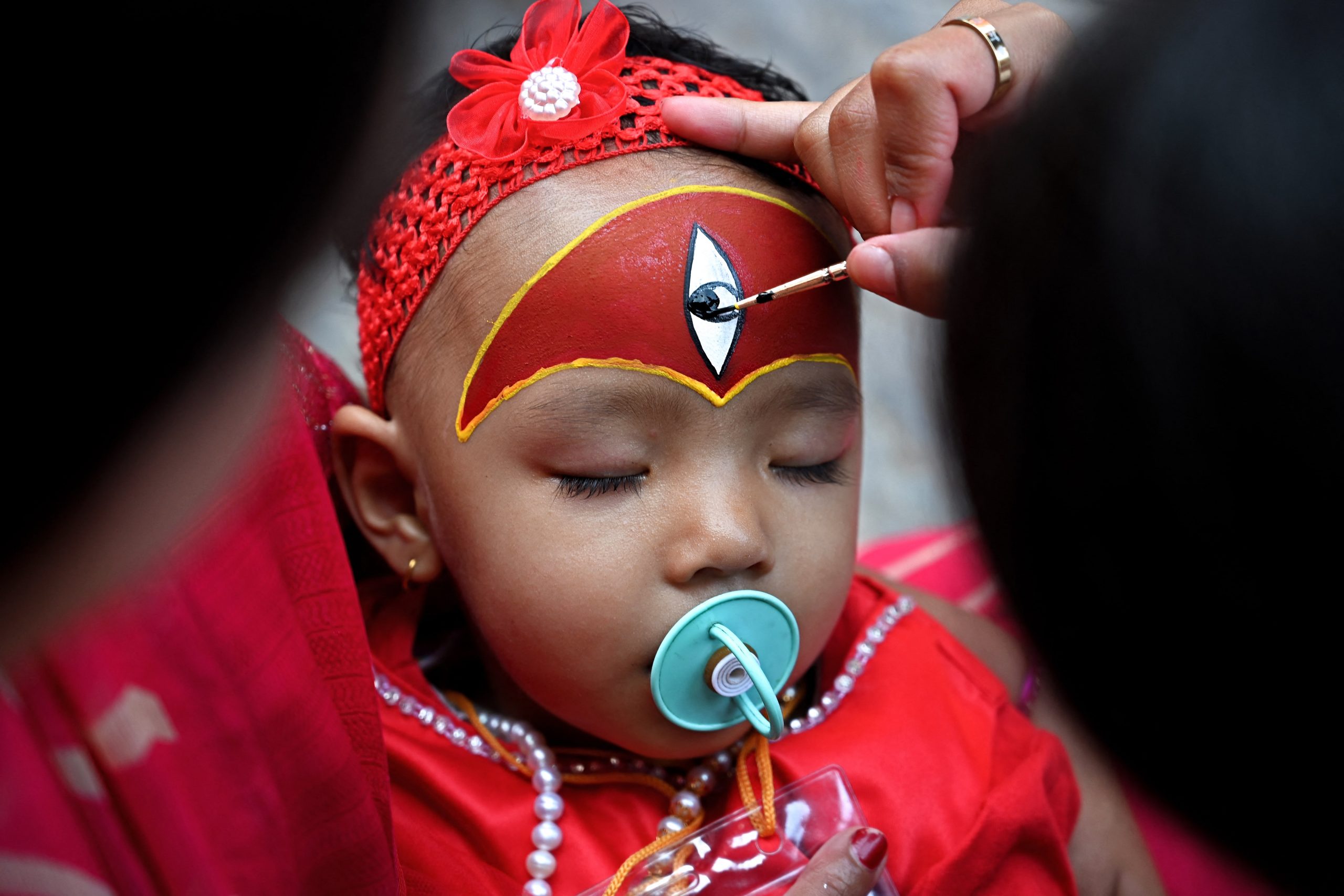
A woman applies make-up to a girl dressed as a living goddess ‘Kumari’ as she prepares to take part in the ‘Kumari Puja’ rituals at the Hanuman Dhoka at Durbar Square in Kathmandu on September 27, 2023. Nepal faced a number of crises throughout 2023, including an economic downfall, natural disasters, and an increase in media rights violations. Credit: Prakash Mathema / AFP
The year 2024 heralded a political turn when Nepal’s Prime Minister Pushpa Kamal Dahal ‘Prachanda’ allied with new partners- the Communist Party of Nepal (UML), the Rastriya Swatantra Party (RSP), Janata Samajbadi Party and the CPN (Unified Socialist) to form a new government under his premiership. This development followed the breakdown of the 15-month-partnership between the Communist Party of Nepal (Maoist-Center) and the Nepali Congress (NC), headed by Pushpa Kamal Dahal. A fresh round of calculations on the future of the current coalition has surfaced in the Nepalese political sphere, with implications for the media in terms of whether or not the incumbent government goes ahead with the controversial media council bill, for example.
The year in review was gloomy in terms of press freedom and the overall state of media. Nepali journalists and media workers were subjected to a series of rights violations through the year, including non-payment of wages and illegal dismissals. Many journalists were forced to let go of their jobs due to constant lack of payment or underpayment, and a few media houses have also been found to urge their staff to quit, citing financial constraints and crisis. Government agencies misused section 47 of the Electronic Transactions Act, 2008 (ETA) to arrest and threaten journalists. Social media platforms operating in Nepal are now under scrutiny with a provision requiring them to set up their offices in the country.
Nepal witnessed multiple crises over the past year. The Real GDP fell to an estimated 1.9 per cent in 2023, regularly declining since 2020. Nearly a million Nepalis, including students, left the country in the last year. An earthquake measuring 6.4M on the Richter scale struck Western Nepal, with its epicentre in Jajarkot district, killing more than 150 people, injuring hundreds and causing large-scale destruction of property. It was the most severe earthquake to hit Nepal since the devasting 7.3M quake in 2015.
The long-awaited bill on transitional justice is still far from ideal. Human Rights Watch and Advocacy Forum-Nepal have said that the bill requires amendments to meet victims’ needs as well as legal standards set by the Supreme Court and those established in international law. The future of transitional justice still remains undecided with the change in coalition partners. The cases of slain journalists Krishna Bahadur Icchuk and Gopal Giri are pending before the Truth and Reconciliation Commission.
Towards the end of 2023, Nepal also witnessed protests demanding the restoration of monarchy led by medical college and hospital owner Durga Prasai. Shortly before the protests, the Nepali government banned TikTok, citing the social media application’s negative effects on social harmony, but the ban was perceived to have been imposed to curb and contain the protest, and was deemed an attack on freedom of speech and expression.
On a positive note, Nepal embraced gender equity by laying the ground for legal recognition of same-sex-marriage. Dordi municipality in, Lamjung legally registered a same-sex marriage of Maya Gurung and Surendra Pandey on November 29, 2023, making it the first such marriage not only in Nepal, but in all of South Asia.
Media Rights Violations
Killings
Arrests
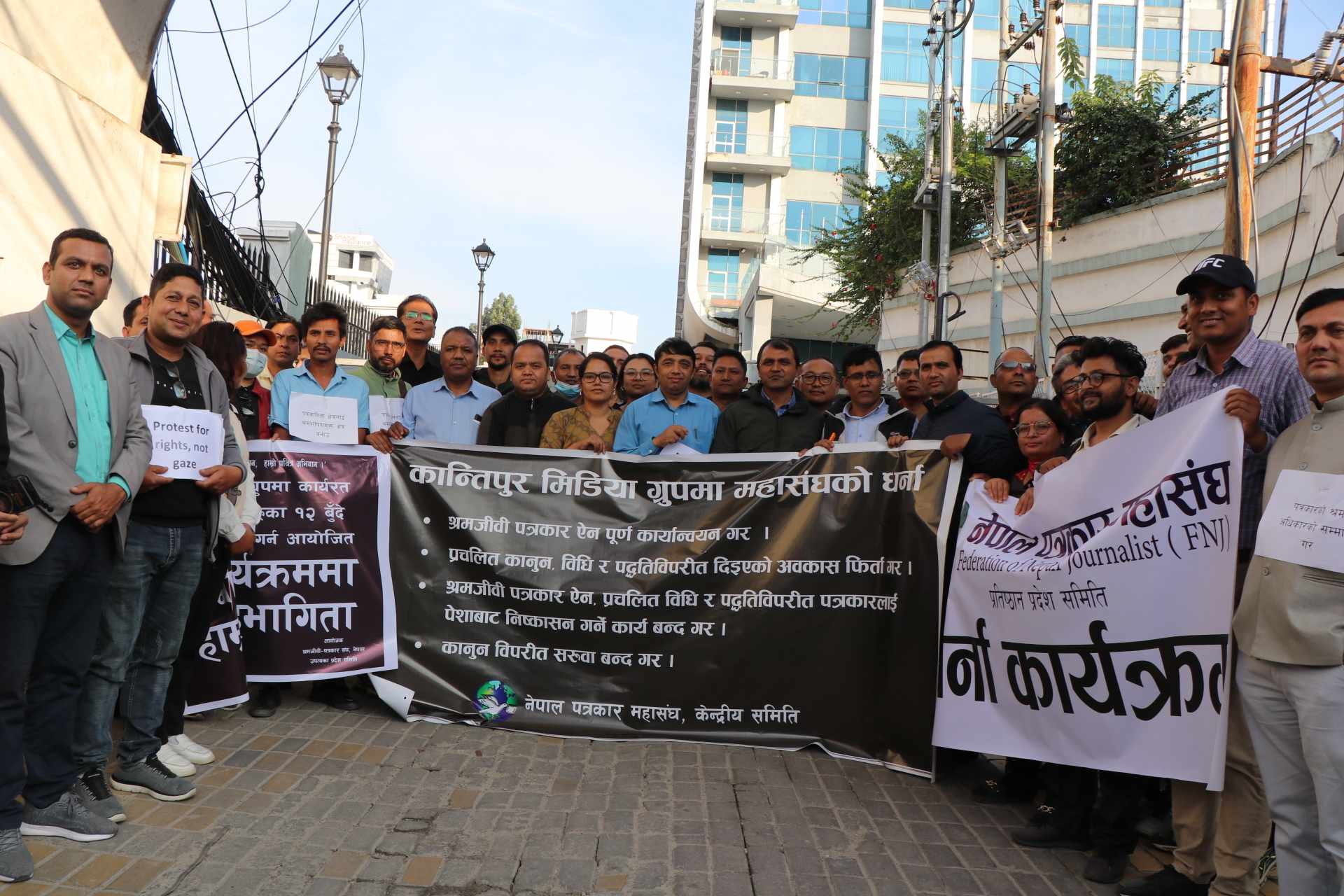
Members of the Federation of Nepali Journalists (FNJ) partake in a protest outside the offices of the Kantipur Media Group on October 11, holding signs and calling for the fair treatment of 82 illegally terminated media workers. Media unions and collectives in Nepal, including FNJ and Nepal Press Union (NPU), played a crucial role in upholding press freedom and providing valuable violations and labour rights monitoring work. Credit: Facebook
The future of transitional justice still remains undecided with the change in coalition partners. The cases of slain journalists Krishna Bahadur Icchuk and Gopal Giri are pending before the Truth and Reconciliation Commission.
Ailing industry
The state of the media industry was not encouraging in the past year. Nepali journalists and media workers continued to face a series of rights violations including the non-payment of wages and illegal dismissals. The Federation of Nepali Journalists (FNJ) Media Monitoring Unit cited professional insecurity as the topmost challenge. According to FNJ, about 700 working journalists filed wage and working condition-related complaints with the federation’s central office. Journalists from prominent media houses were laid off and were also denied basic pay and benefits as mandated by the Working Journalists Act 2006.
In a small victory, in December 2023, in the case of Madhav Basnet and Ravi Manandhar against Kantipur Publications, the Labour Court ordered the payment of 60 per cent of the minimum wage for their services.
More than a hundred media outlets across the seven provinces of Nepal stopped operations in 2023, and an estimated 243 media personnel quit their jobs, according to Kathmandu-based non-profit, Freedom Forum. However, the number could be much higher as there is no central data system to verify how many journalists have been affected by the ongoing crisis.
According to FNJ, incidents of press freedom violations increased in 2023 as compared to 2022. Fifty-eight incidents relating to violations of press freedom were recorded in the Media Monitoring Unit of the FNJ, affecting 13 female and 74 male journalists. The year also saw political party leaders and those in responsible government positions – such as the Mayor – make false accusations against the press and defame the media with baseless allegations such as belonging to opposition political parties.
In terms of media regulation and policy, several proposed laws have been in the pipeline over the years. The Media Council Bill to regulate media content, which aims to replace the existing media content regulatory body, Press Council Nepal, was tabled in parliament in May 2019 and retracted by the government after it failed to enact the bill. In December 2023, the Council of Ministers once again approved the presentation of the bill in parliament.
Similarly, the proposed National Mass Communication Bill which aims to replace old media related laws was drafted a few years ago to regulate online media, print media, radio and television under an umbrella act. The bill also proposed to regulate promotional activities in the media industry and support regulation of media rights at province and local levels under the current federal structure. Though cabinet approval was given twice, the government did not table the bill.
Following the pushback to the Social Media Directive issued in November 2023, the government proposed the Social Media Regulation and Management Bill to regulate social media platforms.
The Public Service Broadcasting Bill has been under consideration in parliament for five years. The bill, which aims to unify state-owned media Radio Nepal and Nepal Television into a public service broadcaster was met with severe criticism for increasing government control rather than establishing a genuinely autonomous public service broadcaster.
The changing coalition governments and lack of stability in parliament has impeded proper discussion and passage of these laws.
Digital police
The Electronic Transactions Act, 2008 (ETA), has long been weaponised to silence dissent in the public sphere. On February 10, 2024, Aishwarya Kunwar, reporter with Nigrani Khabar and Puskar Bhatt with Mountain Television, both privately owned entities, were detained for about four days under Section 47 of the ETA which criminalises online content deemed to be “contrary to public morality or decent behaviour” with a penalty of up to five years’ imprisonment and a fine of NPR 100,000 (USD754). Both had reported allegations of police misconduct and shared their opinion on social media.
Regulation of online media is an ongoing challenge. The country introduced a new rule that required social media companies to set up liaison offices in the country. The government also released a 15-point social media directive on the Operation of Social Networking 2023 in November 2023, based on the ETA. Many platforms have deemed this problematic because it can be misused against journalists. The Press Council of Nepal was found to have taken action against 71 online media, news portals, and television channels, and 18 YouTube channels, including blocking an online news portal, citing various violations of code of conduct, exaggeration, spreading of rumours, etc. but has not turned in any convincing evidence in support of many of the charges.
On November 13, 2023, the Council of Ministers decided to ban the Chinese-owned app TikTok because its content was allegedly ” detrimental to social harmony.” The decision was made a few days after the introduction of Directives on Operation of Social Networking Sites-2023. 1,600 TikTok-related cybercrime cases have been registered with the government in the last four years.
Journalists from prominent media houses were laid off and were also denied basic pay and benefits as mandated by the Working Journalists Act 2006.
The country introduced a new rule that required social media companies to set up liaison offices in the country.

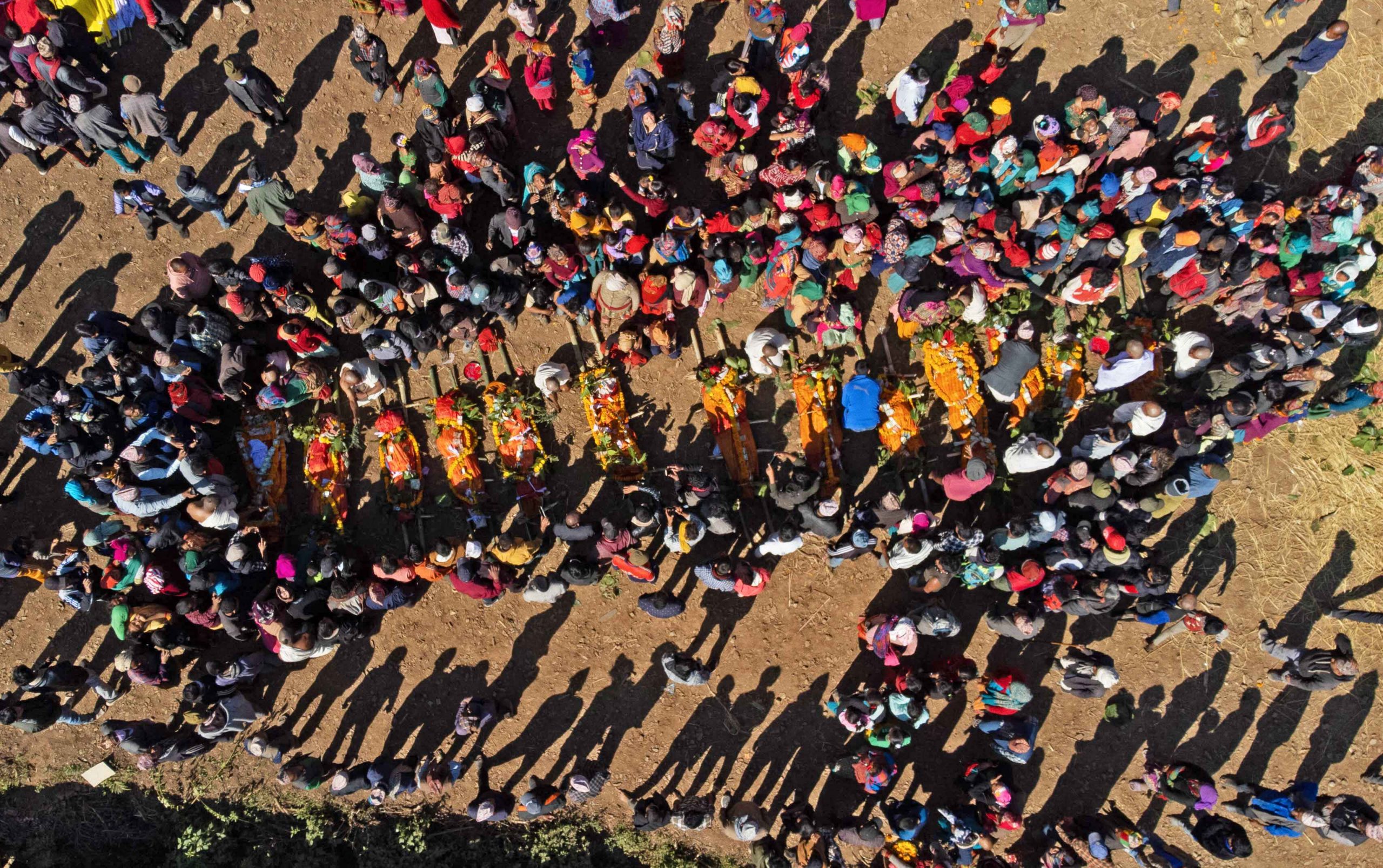
An aerial view shows family members and villagers gathered around the bodies of earthquake victims before a mass cremation ceremony in Chiuri village at Jajarkot district on November 5, 2023. Over 150 people were killed in one of the country’s most devastating natural disasters in almost a decade, with solidarity efforts central to supporting rural media initiatives. Credit: Prabin Ranabhat / AFP
Stop press
According to FNJ’s database, 43 cases of press freedom violation were recorded from May 1, 2023, to March 15, 2024. An analysis of the complaints recorded by the FNJ brings up the following trends: journalists being attacked either verbally, physically, or both, while field reporting; journalists receiving verbal abuse and death threats over their reporting; journalists being harassed and/or denied coverage despite showing their media credentials. Some notable cases are detailed below.
Police high handedness was evident in several cases. On February 28, 2024, Padam Prasad Pokhrel, a member of the FNJ’s Pyuthan branch, was attacked and injured by the municipal police while he was filming the eviction of street vendors in Sundhara, Kathmandu. As Pokhrel was filming, the police attacked him and seized his phone, camera, laptop, and documents, despite him showing his press ID card. On February 21, 2024, the executive editor of Nepalesetimes.com, Tekman Shakya, and correspondent, Sunita Gautam, were mistreated by the police. On the same day, journalists covering an event organised by persons cheated during their foreign employment at the Department of Foreign Employment had to face maltreatment by security personnel deployed by the Kalimati Police Circle, despite them showing their press passes issued by the Department of Information and Broadcasting.
Obstruction of journalists from covering events, arbitrary use of the ETA against online journalists, and physical violence from those not wanting news covered, were common forms of harassment. For example, on February 6, 2024, Krishna Tiwari, was beaten on his chest and head by the operators of the Baba Baijunath Sugar Mill in Rautahat while reporting.
Abduction was another method used to prevent journalists from covering news. On July 24, 2023, Sunil Mandel, journalist at Radio Khaptad Awaz and Nepal Angle Online, was kidnapped from his home and held captive, allegedly under the instructions of Nagendra Khadka, the operator of Hotel Holiday Inn and the district coordinator of the Rastriya Swatantra Party- Bajhang.
A woman journalist, Gita Rana was subjected to similar harassment on June 26, 2023. Rana, Pokhara correspondent for ABC Television, was mistreated and held hostage by the Chief Administrative Officer of Bhirkot Municipality in Syangja district while reporting after informing the Information Officer. The Chief Administrative Officer asked her why she was taking pictures, held her hostage within the premises for an hour, and also deleted all the pictures and videos she had taken. He then handed her over to the police.
The lack of action in cases of crimes against journalists has spotlighted concerns over safety and security of journalists and the non-responsiveness of the government towards this crucial issue.
Male gaze
Women continued to face significant barriers in Nepali media. According to the FNJ, seven of 43 press freedom violations documented involved women. Women journalists continued to be objectified and depicted through a male perspective. Issues related to the absence of women-centric newsrooms and a significant gender pay gap with female journalists receiving lower stipends or salaries compared to their male counterparts surfaced last year as well.
The conference ‘Embracing Diversity, Equity, and Inclusion in Nepali Newsroom’ organised by Nepal Investigative Multimedia Journalism Network (NIMJN) in November 2023 was attended by journalists, editors and media personnel from provinces across Nepal and helped provide a perspective on the media scene in Nepal. The key issues that emerged in the discussions included a lack of policies and interest in diversity, equity, and inclusion (DEI) from the upper management, senior editors and industry leaders. This included the absence of gender-friendly office spaces, proper toilets, provision of sanitary products and disposal systems, non-implementation of DEI policies and guidelines in newsrooms; unfair allocation of stories between male and female reporters, as well non-adherence to minimum wage in the industry, and wage discrimination based on gender.
An issue that emerged was that in many cases, reporters are often limited to only reporting on the gender and community that they represented, rather than being allowed to report based on their interest and skill level. For example, a reporter from the Dalit community would only be assigned stories related to that particular community. However this trend is slowly changing, and a few newsrooms are embracing new trends, with reporters from diverse communities and genders being encouraged to select their own beats and getting the requisite training as a follow-up.
The Sanchirika Samuha, a forum of women journalists and communicators received 23 complaints related to women journalists facing online violence, dismissal from their jobs and not getting their salary on time.
The lack of action in cases of crimes against journalists has spotlighted concerns over safety and security of journalists and the non-responsiveness of the government towards this crucial issue.
A few newsrooms are embracing new trends, with reporters from diverse communities and genders being encouraged to select their own beats and getting the requisite training as a follow-up.

A vendor in Bhaktapur on March 14, 2024 waits for customers to his dried fish stall. Nepal’s economy suffered through 2023, with the media chafing against advertising restrictions and industry-wide income downturns. Credit: Prakash Mathema / AFP
Evolving media
Like previous years, in this year too digital media and social media platforms stood out as the major source of news and information. Attempts to regulate social media through the government’s “Directives for managing the Use of Social Networks” indicated a possible shift in the regulation of digital platforms and compliance of digital media with domestic legal frameworks.
As the issues of non-payment, curtailing of labour rights and sustainability surfaced there were few collaborations and breakthroughs in the Nepalese media scene. There was also a major slump in the advertisement market in media houses and migration of advertisements towards digital media platforms. However, a report by the Freedom Forum pointed out the need to not only boost the advertising industry but also develop mechanisms to distribute government ads proportionately and equitably.
The media industry is also suffocating because of strict government policies. With advertisements from certain industries – such as liquor, or insurance – being prohibited, the total pool of ad revenue available for the media is limited.
With the massive shift to the digital space, are journalists equipped with the necessary skills? The report recommended, “Capacity enhancement of journalists on digital technology including AI in journalism practices is necessary to make them more competitive and familiar with contextual changes and challenges. Massive digital literacy is essential to make social media and other digital space safe.”
Nepali journalists in recent years have been hard put to keep up with the race to newer technologies. There are few institutions that train journalists, but media houses and the government are not investing enough in training journalists.
Even as journalists enhance their skills to make full use of digital tools, they have to deal with state control and intimidation, which leads to a tendency towards self-censorship among journalists especially while doing investigative stories.
No wages, no jobs
The Nepali media went through a significant financial crisis throughout the year 2023 and there have been minimal signs of progress in recent months.
Dozens of journalists working with Kantipur Media Group (KMG), Nepal’s leading private media company protested against the unjust dismissal of 82 media workers. Media workers received ‘retirement letters’ via email that failed to state a valid cause for dismissal, a violation of Nepal’s Working Journalist Act and other labour laws.
The FNJ Committee has reported receiving dozens of complaints about the KMG’s failure to organise regular salary payments, receive dismissal entitlements, or follow proper procedures for contract terminations. The federation held a series of protests at the offices of the KMG, demanding the implementation of minimum wages and the reinstatement of 82 dismissed media workers.
The Kantipur Media Group and the FNJ on December 1, 2023 reached a four-point agreement to end the protest. As per the agreement, journalists and other company employees would be provided facilities as per the relevant legal provisions and the transfers and the terminations would be withdrawn. However, protesting journalists say the agreements were not fully implemented and 20 journalists are still agitating and seeking legal remedy.
Although the media at this juncture faces a ‘sink or swim’ scenario, the government does not seem to have any policies or resources to rescue the media financially. This prevailing media landscape has thus undermined the role of media as the fourth estate.
Nepali journalists in recent years have been hard put to keep up with the race to newer technologies. There are few institutions that train journalists, but media houses and the government are not investing enough in training journalists.
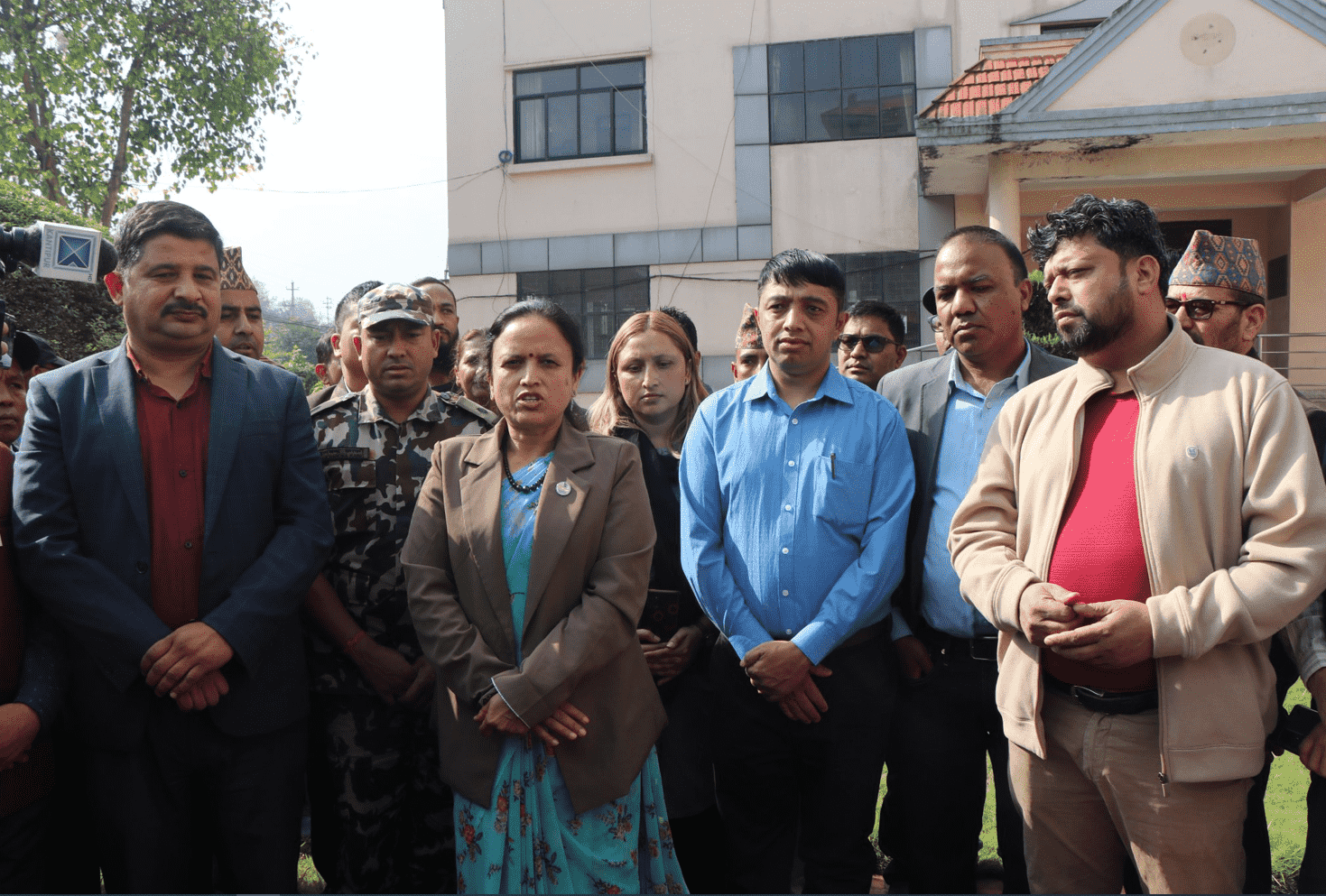
FNJ Members and officials stand with Minister of Information and Communications Rekha Sharma following a march in Kathmandu to commemorate World Press Freedom Day on May 3, 2023. Sharma and her government hold the fate of Nepal’s media in their hands, with several potential interventions able to secure the sustainability of Nepal’s vibrant media for years to come. Credit: FNJ
Crisis of credibility
Along with labour rights violations and journalists’ safety, Nepali media also faces issues of quality and credibility. Challenges arising from disinformation, misinformation, and fabricated news also made headlines last year.
Discrediting media and journalists critical to any parties or leaders is on the rise. The Freedom Forum recorded a total of nine incidents of attacks on journalists on social media. Among those most hostile to journalists were political leaders and their cadre, security persons, government staff and criminals/goons. Journalists investigating corruption, financial irregularities and administrative malfeasance are targeted as in the past. The indifference of the government and parliament towards media reform continued this year too, thereby setting aside media related bills and policies, while the directives and policies on cyber security and management of social network failed to guarantee of freedom of expression and journalist’s rights.
Way forward
Given the crisis of both sustainability and credibility, there is a need to create a favourable environment to institutionalise independent journalism and promote press freedom. Such scaffolding would ensure that independent media can rise above political affiliation and partisanship to make the people in power more accountable. There is also need for media associations and organisations to transcend their alignment with various political parties, to work collaboratively for the journalist community.
Another important issue that needs to be addressed is the sustainability of the Nepali media. Stakeholders must collaborate to find sustainable solutions to deal with the current situation. Media houses and government institutions should ensure space for innovation for the sustainability of media and upholding media ethics and professionalism.
The media in Nepal can generate revenue from international Big Tech like Google and Meta, but the Nepali language is not recognised by the Google ad manager, unlike several regional languages in India. If the government negotiates with social media giants to pay for media content, it could safeguard Nepali media, which is still robust and critical of the powers that be.
As the nation grapples with the economic crisis in all sectors including media, income parity and payment of minimum wages on a timely basis as mandated by law must be adhered to.
A less discussed but crucial issue relates to the well-being of journalists. These concerns must enter newsroom discussions, and collective efforts must be pursued to create a system and culture of openness. An environment must be created for these discussions to be initiated. Training resources related to emotional intelligence, resilience, mindfulness, active listening and mental health literacy for the management of occupational hazards and mental well-being of journalists must be incorporated into journalists’ training as a matter of routine.
Digital literacy to make social media and other spaces safe for journalists and as well other users is also of high importance. Simultaneously, new multimedia reporting trends should be integrated into the newsroom, and a critical approach to Artificial Intelligence (AI) should be adopted in Nepali newsrooms with an emphasis on ethical use.
Above all, in recent days editorial freedom is beset with various problems. Even as the media confront government control, on the other side is the harsh logic of the market. The business side of media companies give short shrift to the editorial side and consider journalists ordinary workers. In order to foreground the public service nature of journalism and its critical role in strengthening democracy, an enabling environment – job security, safety on the field, professional standards and editorial freedom – must be created to leverage their conscience-keeping duty.
Media houses and government institutions should ensure space for innovation for the sustainability of media and upholding media ethics and professionalism.
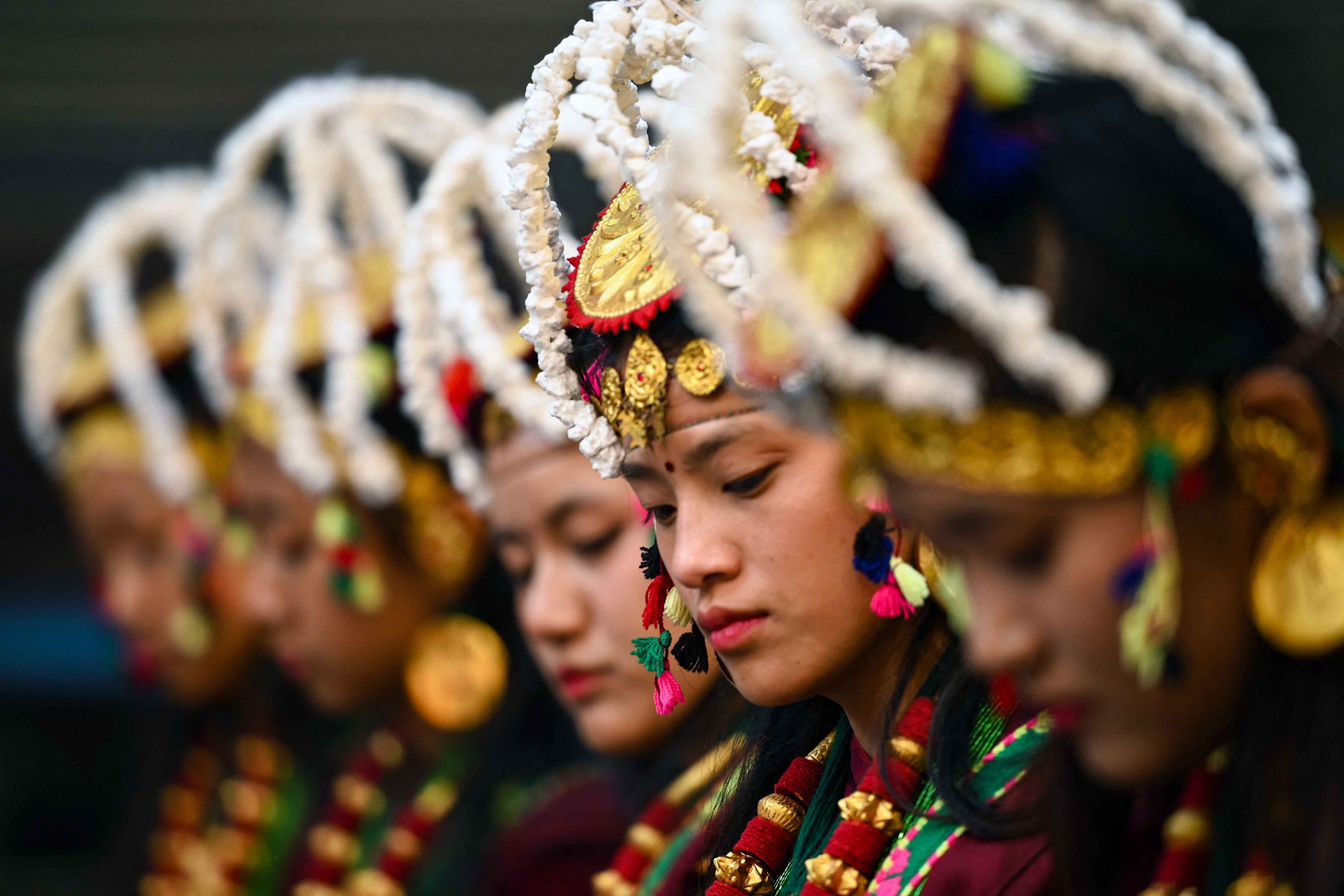
Members of Nepal’s Indigenous Gurung community wear traditional attire on the occasion of the ‘Tamu Lhosar’ festival marking the commencement of Gurung new year in Kathmandu on December 31, 2023. 2024 heralded political developments in Nepal, however labour rights concerns and media rights violations remain ever present. Credit: Prakash Mathema / AFP
